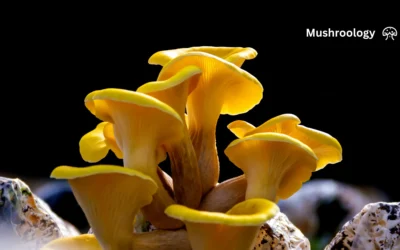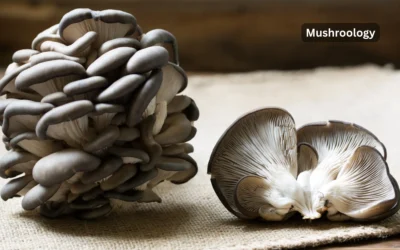Your step-by-step guide to cultivating Pleurotus pulmonarius successfully
You’ve probably wondered if you can grow Phoenix oyster mushrooms (Pleurotus pulmonarius) at home. The good news? They’re one of the easiest mushrooms for beginners to cultivate. These warm-weather fungi grow faster than most other oyster species and tolerate mistakes better than finicky varieties.
Bottom Line: Phoenix oyster mushrooms take 2-3 weeks to colonize substrate and fruit within 4-7 days. You’ll get 2-4 flushes from each growing bag when you maintain temperatures between 75-85°F (24-29°C) for colonization and 65-75°F (18-24°C) for fruiting.
Why you should grow Phoenix oyster mushrooms
Phoenix oyster mushrooms adapt to warmer climates better than regular oyster mushrooms. According to mycological research, P. pulmonarius prefers temperatures between 77-86°F (25-30°C) compared to pearl oysters that need cooler conditions. This makes them perfect if you live in a warm area or don’t have climate control.
The North American Mycological Association identifies Phoenix oysters as the most popular mushroom for beginner cultivation demonstrations. They’re aggressive growers that fruit easily on many substrates, from straw to coffee grounds.
You’ll see results quickly. Most Phoenix oyster mycelium colonizes substrate in 8-14 days, much faster than shiitake or other gourmet varieties that take 4-8 weeks.
What substrate works best for Phoenix oyster mushrooms
You can grow Phoenix oyster mushrooms on almost any organic material. Proven substrates include pasteurized straw, wood chips, sawdust, coffee grounds, agricultural waste, and even cardboard.
Best beginner substrates:
- Wheat straw (easiest to find and prepare)
- Hardwood sawdust from oak, maple, or beech
- Coffee grounds mixed with sawdust (50/50 ratio)
Research by Royse & Bahler found that adding 20% alfalfa hay to wheat straw increased yields substantially. But here’s the thing – alfalfa also increases contamination risk. Start with plain straw until you get comfortable with the process.
How you prepare substrate for Phoenix oyster cultivation
You’ll need to pasteurize your substrate to kill competing microorganisms. The optimal moisture content for Pleurotus mushroom growth is between 50-80%. Here’s what works:
- Hot water pasteurization: Soak straw in 160-180°F (71-82°C) water for 1-2 hours
- Steam pasteurization: Steam substrate at 212°F (100°C) for 60-90 minutes
- Pressure cooking: 15 PSI for 90 minutes (for sawdust substrates)
After pasteurization, let the substrate cool to room temperature and drain excess water. You want it moist like a wrung-out sponge – about 60-70% moisture content.
Safety Warning
- Always pasteurize substrate to prevent mold contamination
- Use sterile techniques when handling spawn and substrate
- Contact your local mycological society for hands-on training
- The North American Mycological Association provides comprehensive mushroom cultivation resources and safety guidelines
How you inoculate Phoenix oyster mushroom substrate
You’ll need Phoenix oyster spawn for inoculation. Use about 10-20% spawn to substrate ratio for fastest colonization. More spawn means faster growth but higher costs.
Inoculation steps:
- Work in a clean area – wipe surfaces with 70% alcohol
- Mix spawn thoroughly through cooled, drained substrate
- Pack mixture into clear plastic bags with filter patches
- Seal bags and label with date
Don’t worry about perfect sterility at home. Phoenix oysters are aggressive enough to outcompete most contaminants if you use good techniques.
Phoenix oyster mushroom incubation conditions
Incubate inoculated bags at 75-85°F (24-29°C) in a dark location. A closet, basement, or spare room works fine. You’ll need 80-90% humidity during this phase.
What you’ll see during incubation:
- White mycelium appears within 2-3 days
- Full colonization takes 10-21 days
- Substrate turns completely white when ready
Phoenix oyster mycelium typically colonizes substrate in 8-14 days under ideal conditions. Don’t rush this step – partially colonized substrate often gets contaminated when moved to fruiting.
How you set up fruiting conditions for Phoenix oyster mushrooms
Once your bags show complete white colonization, it’s time to trigger fruiting. Phoenix oysters need temperatures between 50-75°F (10-24°C) for optimal fruiting.
Fruiting setup:
- Cut 2-3 inch (5-7.6 cm) slits in colonized bags
- Place bags in area with indirect light
- Maintain 85-95% humidity
- Provide fresh air exchange 4-6 times daily
You can use a plastic storage tub with holes drilled for air exchange. Mist the walls (not directly on mushrooms) 2-3 times daily. Like many oyster mushrooms, Phoenix oysters are highly sensitive to carbon dioxide levels.
What lighting do Phoenix oyster mushrooms need?
Blue light stimulates fruiting body formation while longer wavelengths are ineffective. You don’t need grow lights – a north-facing window or fluorescent room lighting for 12 hours daily works perfectly.
The required light levels are low. Research shows Phoenix oysters need light quantities below those of full moonlight in a clear sky.
When and how you harvest Phoenix oyster mushrooms
Phoenix oyster mushrooms are ready to harvest when caps flatten out and edges become wavy. This usually happens 4-7 days after pins appear.
Harvest timing:
- Caps are 2-6 inches (5-15 cm) across
- Edges start to flatten (no longer curled under)
- Before spores drop (mushrooms turn dusty)
Twist and pull entire clusters at the base. Phoenix oysters continue growing even when refrigerated, so consume or dry them within days of harvest.
You’ll get 2-4 flushes from each bag over 6-8 weeks. Rest bags for 1-2 weeks between flushes, keeping them moist but not waterlogged.
Common problems growing Phoenix oyster mushrooms
Green or black mold: Usually means substrate wasn’t pasteurized properly or contamination during inoculation. Start over with fresh materials.
Long stems, small caps: Too much CO2 and not enough fresh air. Increase air exchange and reduce humidity slightly.
No fruiting: Temperature too warm or not enough humidity. Phoenix oysters won’t fruit above 75°F (24°C).
Mushrooms abort: Humidity dropped too low or temperature fluctuated. Maintain consistent conditions.
Health benefits of Phoenix oyster mushrooms you grow
Scientific studies show Phoenix oyster mushrooms contain compounds that may support immune function and cardiovascular health. They’re rich in protein, B vitamins, and minerals while being low in calories.
Research indicates P. pulmonarius may be effective for hay fever treatment by inhibiting histamine release. However, don’t use homegrown mushrooms as medicine without consulting healthcare providers.
Phoenix oyster mushrooms contain beta-glucans that support immune response and antioxidants that help fight free radicals. The protein content rivals many animal products at about 25-30% by dry weight.
Frequently asked questions about growing Phoenix oyster mushrooms
Q: How long does it take to grow Phoenix oyster mushrooms from start to harvest?
A: Complete colonization takes 2-3 weeks (14-21 days) at 75-85°F (24-29°C), then fruiting occurs within 4-7 days under proper conditions.
Q: What’s the best substrate for beginners growing Phoenix oyster mushrooms?
A: Start with pasteurized wheat straw. You’ll need about 2-5 pounds (0.9-2.3 kg) of straw per growing bag, maintaining 60-70% moisture content.
Q: When is the best temperature for Phoenix oyster mushroom cultivation?
A: Incubate at 75-85°F (24-29°C) for colonization, then drop to 65-75°F (18-24°C) for fruiting with 85-95% humidity.
Q: How many harvests can you get from Phoenix oyster mushroom bags?
A: Expect 2-4 flushes over 6-8 weeks. Total yield typically equals 20-40% of substrate dry weight.
Q: What equipment do you need to grow Phoenix oyster mushrooms at home?
A: Basic setup requires plastic bags, spawn, substrate, thermometer, spray bottle, and clean workspace. Investment runs $30-50 for first batch.
Helpful resources for families and beginners
- North American Mycological Association (NAMA)
- American Mushroom Institute
- “Growing Gourmet and Medicinal Mushrooms” by Paul Stamets
- Local mycological society chapters for hands-on workshops
Now you understand how straightforward Phoenix oyster mushroom cultivation can be. You’ll see better results if you start with quality spawn and maintain consistent environmental conditions.
Your next step: Source Phoenix oyster spawn from reputable suppliers and practice with small 1-2 pound (0.5-0.9 kg) test batches before scaling up.





